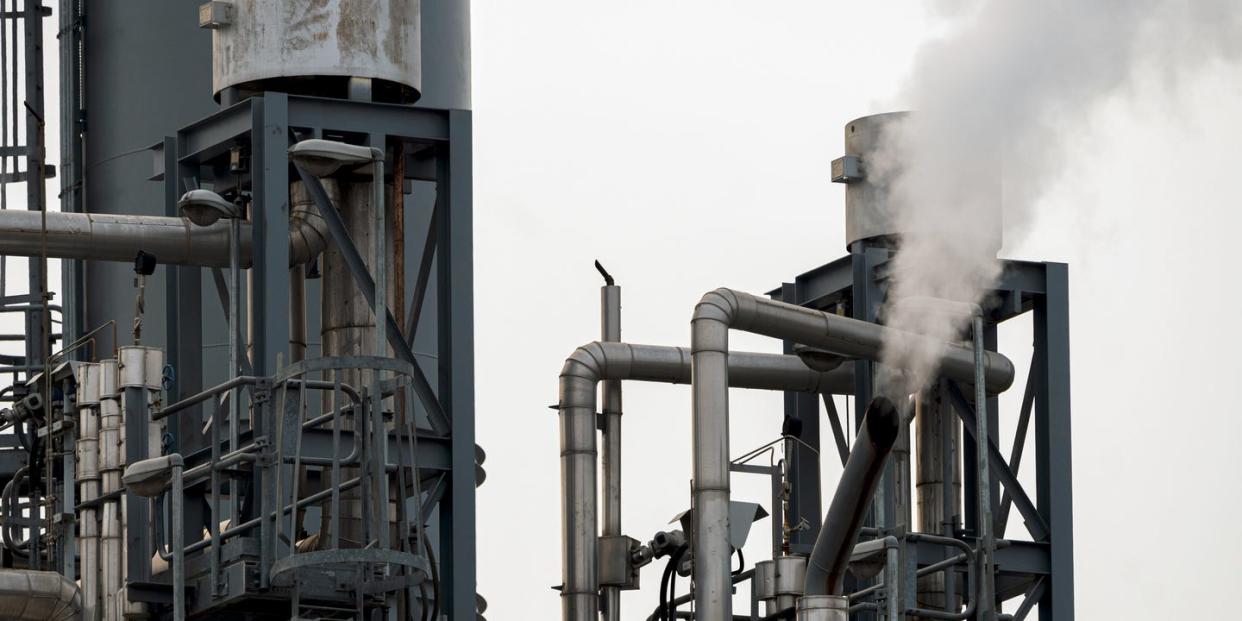Everything You Need to Know About Clean Coal

“Clean coal” usually means capturing carbon emissions from burning coal and storing them in underground pockets of porous rock.
While carbon capture and storage (CCS) technically does work, it is expensive to build new infrastructure and retrofit old plants.
There are other dangers associated with burning coal, too.
For decades now, clean coal has been a political pipe dream. It’s the idea that coal—our oldest, dirtiest energy source—could be reshaped in a way that lets us keep using it without doing so much harm to the environment. But what is it, exactly?
➡ The world is weird. We’ll show you how it works.
The term clean coal has been applied to many technologies, ranging from wet scrubbers, which remove sulfur dioxide from coal-generated gas, to coal washing, which removes soil and rock from coal before it’s sent to a factory. Hypothetically, the term could be applied to anything that makes coal plants more efficient, like digitization. However, when people talk about clean coal these days, they’re typically talking about something called carbon capture and storage (CCS).
CCS technology has been around since the 1980s. While the other technologies mentioned above cut down on sulfur dioxide and coal ash (which are important), CCS is meant to handle the big environmental nightmare: the heat-trapping gas largely responsible for global warming, carbon dioxide (CO2).
Coal plants today typically use what is called pulverized coal. That means the coal is ground up, burned, and the steam from that burning drives turbines. There’s also newer integrated gasification combined cycle (IGCC) technology, which sends the gas through a combustion turbine to generate electricity, and then routes excess heat from that process to generate even more electricity through a traditional steam turbine.
In either process, there are multiple points at which CCS technology could intervene. One such point is called pre-combustion. At this stage, an air separation unit produces a stream of almost-pure oxygen, which flows into a coal gasifier. Gasifiers are essentially tanks that produce synthetic gas mixtures known as syngas.
The oxygen in this coal gasifier reacts with fuel to create a syngas made up of hydrogen, carbon monoxide, water, and CO2. (This form of syngas is nothing new: Invented in the 1790s by William Murdoch, it was used to power gas lights in many towns in the 19th century and gained the nickname “town gas.”)
CCS technology sends the syngas to a shift reactor, where it encounters steam. That steam transforms the carbon monoxide that’s present into hydrogen and even more CO2. The CO2 is then captured from the gas stream, compressed, and dehydrated. That leaves it ready for transport and storage.
“Transport and storage,” when applied to CCS technology, basically means sending the CO2 in a pipeline several kilometers below the earth and into rock, the idea being that it’s stored there rather than released into the atmosphere to contribute to climate change.
Ideal spots for this include old oil and gas fields, which have already dug into the earth, but any deep saline formation, filled with porous rock and salty water, will do. Ships could also send the CO2 to refineries in the ocean. The idea is that the CO2 stays there for millions of years and eventually chemically binds with the surrounding rock.
The technology can also be used post-combustion and with oxygen-based fuel. Post-combustion uses a solvent to bind with CO2, which then drives it off into storage. Oxygen-based CCS burns away the CO2 in a boiler. All three work—CCS has been praised by everyone from the Intergovernmental Panel on Climate Change to the International Energy Agency.
The Obama Administration invested $84 million in the technology and, in a rare act of bipartisanship, one of those investments was trumpeted by former Energy Secretary Rick Perry. That plant, Petra Nova, is the world’s first post-combustion plant and is about 30 miles southwest of Houston, where it captures 1.6 million tons of carbon dioxide each year.
The question is mostly one of cost and efficiency. CCS plants are expensive to build and maintain, and retrofitting the technology onto older plants requires an increase in power and costs. A 2019 report from the Global CSS Institute estimates it could cost “$100 billion annually” to develop CCS, and that the technology represents “a classic catch-22 scenario. The only way costs can decrease is by installing a large number of CCS projects worldwide. However, the high cost of CCS is challenging project development.” An estimate from the Global CSS Institute's 2022 report suggests that a total investment sum of between $650 billion and $1.2 trillion will be necessary to meet goals by the 2050 climate deadline.
📚 Further Reading
The technology itself has its critics, too. While CCS can effectively capture around 90 percent of the CO2 produced at power plants, some people point to the fact that coal has so many pollutants that no singular technology can capture all of them. They point to mercury, nitrogen oxide, and other poisonous contaminants that coal plants could still produce even if they’re not pumping out CO2.
Still, the International Energy Agency (IEA) estimated in 2019 that the global storage rate could exceed 7 gigatons of carbon dioxide per year, which works out to a staggering 15 trillion pounds.
CCS could offer a viable alternative to modern coal plants because even as global fossil fuel demands drop steadily every day, there’s still a lot of work to do. The IEA “has found that the world needs to capture and store almost 5,600 million tonnes per annum (MTPA) of CO2 in 2050 to meet a scenario where the Earth’s temperature rises only 2 degrees Celsius, according to a 2022 Global Status of CCS report. “Current carbon capture capacity for projects in operation or under construction sits at approximately 40 MTPA,” a paltry figure in comparison.
“The numbers speak for themselves,” the report says. “It means that there is a lot of ground to make up.”
You Might Also Like

